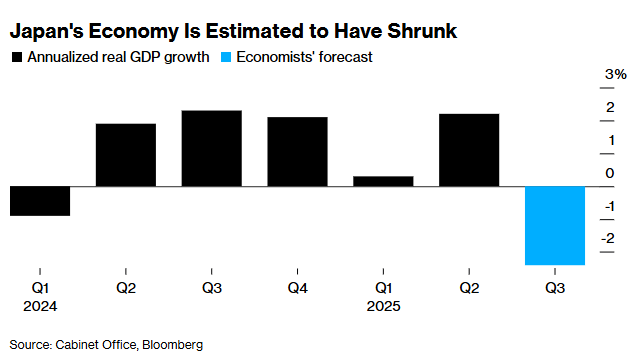Japan’s new government plans to roll out a stimulus package exceeding 17 trillion yen (approximately $110 billion) to counter rising prices and revive economic momentum. The move follows a 1.8% annualized contraction in Japan’s economy during the third quarter of 2025, which ended a six-quarter growth streak.
Analysts say the scale of the liquidity boost could place renewed pressure on the yen and redirect capital toward risk assets, including Bitcoin (BTC).
SponsoredJapan’s Economic Contraction Fuels Policy Response
According to Bloomberg, the economy contracted less than many economists expected. Forecasts had indicated a 2.4% decline, so the actual 1.8% drop proved somewhat milder. Still, negative growth signals a key shift after 18 months of expansion.
“Japan’s economy was solid in the first half of this year and today’s GDP showed that momentum is halted temporarily. I expect Japan’s economy to be back on a moderate recovery trend going forward.” Yoshimasa Maruyama, chief market economist at SMBC Nikko Securities said.

The GDP contraction provides Prime Minister Takaichi with further support for her ambitious fiscal plans of a 17 trillion yen stimulus package.
“Japan is trying to help households absorb higher prices without forcing the central bank to slam on the brakes, and at the same time fund the industries that must anchor its next decade. Japan is the test case. The US is the audience. And the spillover effects will tell us more about the next decade than the headline number ever will,” an analyst wrote.
Still, this timing results in an unusual divergence: While the government prepares a major stimulus injection, the Bank of Japan remains poised for possible interest rate hikes. The BOJ maintained its benchmark rate at 0.5% at its last meeting in October.
Nonetheless, Governor Ueda has hinted that conditions may warrant a rate increase as soon as December. Such a mix could spark currency volatility and shift capital flows globally.
SponsoredWhat Does It Mean For Bitcoin?
Meanwhile, market analysts expect a large liquidity injection to weaken the yen. When governments increase the money supply, currencies often decline and investors seek alternative stores of value, especially those viewed as hedges against inflation.
Bitcoin often benefits from such moves. The cryptocurrency attracts capital during times of currency devaluation and monetary stimulus. Analysts note that liquidity often enters risk assets before reaching broader markets.
“When Japan turns on the fiscal taps, the yen weakens, capital moves outward, and global liquidity picks up. And every time that happens, Bitcoin reacts first. If this package goes through, it becomes one of the strongest macro tailwinds heading into 2026. The liquidity wave is building again, quietly,” an analyst added.
The timing coincides with a broader easing in global financial conditions. A market watcher noted that in the US, the end of the government shutdown, a Treasury General Account balance near $960 billion, and expectations from JP Morgan that roughly $300 billion will flow out of the TGA in the coming weeks all point toward an upswing in dollar liquidity. At the same time, the Federal Reserve’s quantitative tightening cycle is slowing and is set to conclude on December 1.
China is adding to this backdrop with steady weekly injections of more than ¥1 trillion into its own economy. Together, these developments suggest that global liquidity is turning more accommodative — the opposite of the tightening seen in late 2021.
The analyst argued that this environment increases the likelihood that Bitcoin’s recent weakness may be a bear trap, with the asset potentially positioning for a stronger move as liquidity expands worldwide.
“This doesn’t mean instant moon. It means that BTC is more likely in a bear trap, before the next possible move starts,” Bull Theory stated.
The coming time will reveal whether Japan’s contraction and the stimulus package drive the expected Bitcoin rally. As global liquidity changes, market participants will watch both traditional and crypto indicators to spot the next major trend.

